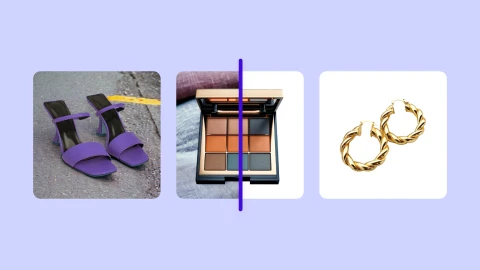How to sell vintage clothing online: 10-step guide


In a time where fashion trends cycle faster than ever, vintage clothing offers a timeless appeal that combines style with sustainability. If you love to hunt for that perfect 1960s cocktail dress or the ultimate 1980s bomber jacket, transforming this passion into a vintage clothing business could be your calling.
Not only does selling vintage clothing online allow you to share your curated finds with a wider audience, but it also puts you at the forefront of a growing movement towards conscious consumerism. As buyers increasingly seek out ethical alternatives to fast fashion, vintage clothing stands out as both an eco-friendly choice and a stylish statement.
But where do you start? Navigating through the journey of establishing your vintage brand online, from sourcing unique pieces and mastering product photography to setting strategic prices and engaging with your audience, can feel overwhelming.
Whether you're starting from scratch or aiming to expand your physical storefront online, read on for a step-by-step guide on how to succeed in the competitive yet rewarding marketplace of selling vintage clothing online.
Why sell vintage clothing online?
Before we dive into how to sell vintage clothing online, let’s take a quick look at this growing market.
According to Statista, in 2022, the global resale and second-hand apparel market was estimated to be worth $177 billion and it’s projected to grow to $351 billion by 2027.
In recent years, customers—specifically Millennials and Gen Z—have become more conscious of their buying behavior and are looking for more affordable and environmentally friendly clothing options, making shopping for vintage clothing more mainstream and leading to a dramatic increase in sales and market size.
 According to our data, resellers are one of the most common Photoroom use cases. These users (Pro plan) account for nearly 20% of all image exports from the Photoroom app.
According to our data, resellers are one of the most common Photoroom use cases. These users (Pro plan) account for nearly 20% of all image exports from the Photoroom app.

What’s the difference between vintage, retro, and antique clothing?
Understanding the distinction between vintage, retro, and antique is vital for accurately describing and marketing your clothing items.
Vintage clothing refers to garments that are at least 20 years old and up to 100 years old, representing the fashion of a specific era in the past. Vintage pieces are valued for their authenticity, quality, and timelessness.
Retro clothing is new or reproduced clothing that imitates the style of a previous era. Retro items are designed to evoke a sense of nostalgia but are not genuine pieces from the time they represent. Another commonly used term is repro, for reproduction.
Antique clothing includes garments that are over 100 years old. These pieces are often considered collectibles or museum items due to their age and historical significance.
How to sell vintage clothing online: 10-step guide
1. Find your niche
You may have a great idea for your vintage clothing business, but if you don’t hone in on your specific angle, it will be hard to develop marketing strategies to reach your target audience and get noticed in the sea of vintage clothing stores. You can choose an angle based on your interests or personal style or use one of these ideas as a starting point:
Luxury or high-end vintage designer clothing
Vintage clothing assortments by decade
Vintage evening wear, sports gear, or another occasion
Retro or repro clothing in a vintage style
Vintage sports jersey or band t-shirts
Trends or themes like 1970s disco, 1980s grunge, or 1990s hip hop
Humberto Leal Treviño, founder and CEO of Vintage Packs found his niche by sourcing products he likes and wears. His inspiring story started after he lost his job in 2017 and discovered his passion for vintage.
“I went to thrift stores, and looked at things that I like,” says Humberto.
On the same night that he set up his shop, he made his first sale for $16.
“It was euphoric, I couldn’t sleep. I was ready for the thrift store to open so I could go back and do it all over again,” says Humberto.
Before you go all in on your niche, ask yourself the following questions:
Does it align with your style? Sourcing vintage clothing is easier if you can look for pieces you’d wear. Plus, you know more about the brands and styles so it will be easier to find items to sell in over-packed thrift stores.
Do you want to be a trend follower or a trendsetter? Setting new trends sounds appealing, but vintage clothing can sell better if it aligns with current styles. Research seasonal fashion trends to provide some direction and then add your own twist.
Is your angle too broad or limited? Choosing a niche that’s too specific could make it hard to find enough inventory. But if it’s too broad, narrowing down your assortment can be a constant challenge. Find a sweet spot that makes it easy to spot and merchandise your vintage finds.
Do a lot of other vintage clothing stores have the same angle? If you notice a lot of other stores are targeting the same niche, first think about how you can be unique, and if you can’t come up with anything, consider modifying your angle.
You might also be interested in: Add a light blue background to your pictures
2. Build your brand
Defining a strong brand early on is crucial to attracting the right audience, guiding future team members as you grow, and maintaining a cohesive focus throughout your business journey.
“Make sure you have a good website and logo, and that your packaging is on point,” says Humberto.
By addressing several key questions, you can craft your brand's narrative, shape your visual identity, articulate your mission, and gain a clearer understanding of who your ideal customer is.
Questions to consider:
Who is your target audience?
How do you want people to identify your brand? (Name, logo, colors, photography, etc.)
What is your brand voice?
What’s your mission?
What are your values?
These brand guidelines will serve as a reference point when designing your website and selecting pieces for your collection. As your business expands and you bring on new staff, it will ensure that your messaging remains consistent and true to your brand's core values.
3. Evaluate costs
Starting a vintage clothing brand can be an exciting venture with a relatively low initial investment, thanks to modern tools and technology. You can launch your business from the comfort of your home, using online marketplaces to sell piece by piece and then gradually scale up. However, understanding and planning for the costs involved is crucial for long-term success.
“The first expense after inventory is finding a location to work out of,” says Humberto. “I started working out of my home and then I worked out of a storage unit for a couple of years. But it wasn’t until I got my own little warehouse that things started taking off for me because of the environment that I put myself in. Taking yourself seriously is the most important thing.”
Here are some important factors to consider:
Initial investment and inventory costs
Cash flow management
“From the very beginning, I always paid myself a little salary,” says Humberto. “So it was never all my money. I always separated myself from the company. I always took it very seriously. There have been weeks when I didn't pay myself to keep the money in the business. It’s important to understand that the business comes first, then it's your staff, and then it's you.”
Overhead and scaling costs
E-commerce and operational expenses
Funding growth
Alternative models (drop shipping)
“You can do everything yourself up until a certain point, but eventually, you're going to have to start bringing good people in to help you grow because you can't do everything at once,” says Humberto. “So hiring good people, paying them well, taking care of them, as well them taking care of you, is another big part of it.”
4. Source vintage clothing
There are a few different ways you can source inventory for your vintage clothing store.
Thrifting for vintage finds
Starting with thrift stores is a smart first move. These places are treasure troves for unique pieces if you're diligent. Here are some tips for a successful thrift shopping experience:
Visit frequently, especially after new stock arrivals (inquire about restock days).
Have a focused shopping list to streamline your search. If you’re shopping as a team, share a detailed style guide to make sure everyone's on the same page.
Carefully inspect each item for quality. Thrift stores may not vet items as rigorously as specialty vintage shops.
Educate yourself on vintage identifiers like tags, zippers, and cuts, by studying past fashion trends.
Always carry cash and spacious bags for unexpected finds.
 💡 PRO TIP: Build connections with customers by documenting your thrift shopping process (like Vintage Packs), to give them a behind-the-scenes look at how you run your business.
💡 PRO TIP: Build connections with customers by documenting your thrift shopping process (like Vintage Packs), to give them a behind-the-scenes look at how you run your business.
Broadening your search
Beyond thrift stores, there are many other ways to source vintage clothing to sell.
Auctions offer a mix of in-person and online opportunities. Register on large platforms like eBay or smaller ones like Invaluable to get auction notifications.
Estate sales are ripe with potential, often featuring an array of vintage clothing. Stay aware of upcoming sales through local estate sale companies' mailing lists.
Use online marketplaces and classifieds like Craigslist for leads on garage and estate sales in your area.
Hire pickers to streamline sourcing once your business is more established, delegating the thrift store visits to a dedicated individual.
Wholesale purchases allow you to buy in bulk at reduced prices. Establish trade accounts with wholesalers for access to large quantities of vintage stock.
Consider consignment arrangements or set up a program to buy or consign items directly from customers, reducing upfront costs.
Flea markets and meetings with private collectors can also be fruitful, especially towards the end of the day or season when sellers are eager to get rid of inventory.
Collaborating with wholesalers
Wholesalers typically acquire their inventory from unclaimed thrift store items before they get sent to overseas rag houses. Specialized pickers then sift through these to find pieces suitable for resale to vintage shops. Establishing relationships with wholesalers can provide a steady supply of stock, but it's important to do quality checks to ensure each item fits your brand's standards.
“I've been doing business with a lot of my suppliers for many years now, up to six years for some,” says Humberto. “We've been doing business consistently, making each other money. The most important thing is building solid, consistent relationships. Make sure you always pay on time and buy as much as you can.”
Key considerations for selecting the right vintage wholesale partner:
Reputation and reviews. Investigate what other vintage sellers have to say about their experiences with the wholesaler. Positive feedback from peers can be a strong indicator of reliability and quality.
Purchasing flexibility. Look for wholesalers that offer various buying options, including the ability to personally visit or select items through video to ensure the pieces meet your standards. Some may only sell in bulk, limiting your ability to choose specific items.
Quality of stock. Confirm whether the wholesaler provides high-quality, A-grade vintage items. It's important to know if they also deal in lower grades which might include worn or damaged goods, and how they categorize their inventory.
“On a scale from A to C, A is the highest grade, B is the middle, and C is the lowest grade,” says Humberto. “B might have a little stain that you can wash out or it might be older and washed out by the sun.”
Brand selection. Determine if the wholesaler specializes in premium branded clothing. This can help draw in customers looking for specific labels.
Minimum order quantity (MOQ). Understand the wholesaler's MOQ to ensure it aligns with your budget and storage capacity. This way you can avoid overspending and overstocking.
Product variety. Check if purchases must cover a range of product categories as this may affect your ability to focus on your niche.
Logistics and costs. Consider the wholesaler's location in relation to yours to assess potential shipment times and the possibility of incurring customs charges on imported goods.
5. Determine an inventory management system
Managing vintage clothing inventory requires a unique approach due to the one-of-a-kind nature of each item. As your collection grows, maintaining an organized system is essential to operate efficiently and avoid the chaos of a cluttered storage space.
It’s important to develop a structured system for sorting, storing, and cataloging your inventory to streamline the shipping and fulfillment process.
“We organize inventory on hanging ranks and identify items through SKU numbers,” says Humberto. “For our packs, we track them per pack. So once we get the inventory in, we wash it and then we size the t-shirts out into packs of S, M, L, and so on. We use a spreadsheet to keep track of it.”
Key tips for vintage inventory management
Visible storage. Use plastic bins for accessories and open racks for clothing to make sure everything is visible and accessible.
Proper protection. Utilize garment bags to shield clothing from dust and damage, opting for breathable materials over plastic.
Appropriate hanging. Use padded hangers to prevent damage from creases or rust, avoiding wire and certain wood hangers.
Light exposure. Keep items away from direct sunlight to prevent fading.
Climate control. Store items in a space with regulated temperature and humidity to protect against fabric pests and moisture damage.
Organization. Sort items by category and color so it’s easy for you and your staff to retrieve them.
 Vintage Packs keeps its inventory neatly organized and visible.
Vintage Packs keeps its inventory neatly organized and visible.
Key tips for cleaning and repairing vintage clothing
Make sure your vintage clothing items are clean and as described and transparently communicate any imperfections to prevent returns. Here are some maintenance tips:
Care instructions. Follow the label or research cleaning methods based on fabric type and condition.
Steaming. Opt for steaming over ironing to refresh items without causing damage.
Gentle cleaning. Hand wash delicate items and tackle stains carefully.
“We take everything to get washed so it smells good and looks clean,” says Humberto. “If white t-shirts come a little bit stained or yellow, we bleach bath them to make sure they come out crispy white.”
Expert cleaning and repair. Use experienced dry cleaners for vintage fabrics and a reputable tailor—or learn basic sewing skills—for repairs.
“If things have tears that we can sew or zippers we can fix, we repair them in-house,” says Humberto. “But if it's not, then we just donate them.”
Color separation. Avoid color bleeding incidents by washing colors separately.
Upcycling. Transform damaged or soiled items into sellable pieces through creative upcycling.
6. Photograph your vintage clothing
Unlike standard clothing retailers that might organize seasonal photoshoots, having a vintage clothing business has the unique challenge of photographing new stock regularly. It’s important to create high-quality product images to increase sales.
In fact, according to an Etsy survey, 90% of shoppers said the quality of the photos was “extremely important” or “very important” to a purchase decision. Even more important than the retail price, shipping costs, and reviews. 
“You tell stories through photography,” says Humberto.

“When shoppers see a good product shot that’s clean and that looks good, it makes them want to buy it even more,” adds Humberto. “Photoroom has allowed us to do more product, upload more, faster, without having a high skill level of editing or design.”
 You can build an in-house photography studio, hire a photographer, or grapple with editing images in Photoshop yourself, or you could try Photoroom’s AI photo editing tools to enhance your product photos from your smartphone or desktop in seconds.
You can build an in-house photography studio, hire a photographer, or grapple with editing images in Photoshop yourself, or you could try Photoroom’s AI photo editing tools to enhance your product photos from your smartphone or desktop in seconds.
Start with the following visual AI tools:
AI Backgrounds. Erase image backgrounds in a few seconds and replace them with an existing Photoroom template or your AI-generated creation.
Retouch. Clean up images and remove any object, person, or watermark in three seconds.
AI Shadows. Add realistic, studio-quality shadows instantly to your product images.
Bulk resize and image editing. Efficiently adjust and edit batches of images to meet various social media and sales channel requirements.
AI Expand. Repurpose your photo material or recover objects outside the frame layout with AI Expand.
📚 Further reading:
7. Set retail prices
It’s crucial to follow the basic rules of pricing a product to make sure you’re considering the cost of the item and other expenses and overhead involved, so you can make a profit.
But it’s less important to use formulas like multiplying the wholesale cost by two or three, for example, because depending on the types of vintage clothing you sell, some can be valuable.
It’s helpful to set a specific price range, depending on your target market, while looking at each garment independently.
“The grade and type of product impact the price,” says Humberto. “We also take other factors like embroidery, graphic size, and rarity into consideration. For some stuff, like rare or band t-shirts you might have to do some research, but if you’ve sold enough of a certain type of product already, then you know what price points work”.
Some factors to consider include:
The overall condition of the item
How rare it is
If it’s in demand
The age of the garment
Whether it’s wearable
If it aligns with current fashion trends
The brand label (fast fashion vs luxury)
You can also search for similar vintage clothing on marketplaces like Etsy, eBay, and Vinted to determine the right pricing strategy for specific items.
For example, let’s say you’re selling a pair of vintage Reebok high-top sneakers in red and you see 10 other sellers listing a similar product. You can lower your price to be more competitive and attract more buyers. If you notice that most of the sneakers other sellers listed have scratches and look more worn than yours, increase your price.
“I always like to say, a fast penny is better than a slow dime," says Humberto. “Volume is always going to beat us, so we try to price everything to move. We offer three t-shirts for 45 to 50 bucks, while everyone else sells one shirt for 50 bucks.”
8. Create your online vintage clothing store
Before you get into the nuts and bolts of setting up your store, it’s important to first look at where to sell vintage clothing online. Do you want to create an e-commerce store on Shopify or would listing your products on a marketplace like Etsy, eBay, or Vinted make more sense for your business?
Here are a few places you can sell vintage clothing online:
Etsy’s marketplace is dedicated to handmade, vintage, and unique goods, providing a targeted customer base for vintage clothing sellers.
Vinted specializes in second-hand fashion, offering a community-driven platform that's perfect for vintage sellers looking to reach eco-conscious shoppers.
eBay's vast and diverse marketplace is ideal for reaching a wide audience and offers the flexibility of auction and fixed-price listings.
Poshmark's social commerce platform focuses on fashion, making it a great place for selling vintage clothing within a community passionate about style.
thredUp's consignment model is a good choice if you’re looking to reach a broad audience without the hassle of managing individual listings and shipping for products.
Depop reaches a youthful demographic and emphasizes unique fashion, making it a great platform if you’re looking to connect with fashion-forward, vintage-loving buyers.
Facebook Marketplace helps you reach local and global customers, making it a versatile space for selling vintage clothing directly to a wide and varied audience.
Instagram's visually driven platform makes it easy to creatively showcase vintage finds, build your brand, and engage directly with customers.
TikTok's massive, engaged audience and viral potential make it an innovative platform for selling vintage clothing through dynamic, short-form video content.
Shopify gives you complete control over branding, customer experience, and profit margins, something that’s essential for establishing a distinguished vintage clothing brand.
💡 PRO TIP: Photoroom has product photography templates for sales channels like Etsy, Depop, Instagram, Shopify, and more. Sign up now and download the app (iPhone, or Android) to start creating high-quality images that can help boost your online vintage clothing sales.
Once you choose a platform, use the following checklist as a guide to set up your store and list your first batch of products:
 ✓ Store design. Depending on the platform you use, you can customize the design with your branding and logo.
✓ Store design. Depending on the platform you use, you can customize the design with your branding and logo.
✓ Product pages. Include detailed descriptions and photos from various angles on all product pages including information about materials, fit, condition, and care instructions. This can help reduce returns and boost SEO (search engine optimization), making your products more visible to searchers on the web.
✓ Collections. Create collections to categorize products by brand, style, theme, gender, period, or any other criteria that apply to your business.
✓ Policies and contact. Create about, contact, and FAQ pages so shoppers can easily find information about your brand story, shipping and returns policies, vintage garment care, and any other relevant information. Provide as much detail as possible to reduce confusion and time spent on customer service.
✓ Marketing. Add social media icons with links to your various business accounts to the footer of your website or in your seller's profile, depending on the platform you use. This way, customers can easily follow you. It’s also crucial to collect email addresses so you can stay top of mind. Depending on the platform you use, you may not have control over collecting email addresses, but if it’s possible, set up an email subscribe pop-up form.
9. Develop a marketing plan
Now that your online vintage store is live, it’s time to spread the word. Here are some marketing tools you can use to get exposure and reach your target audience.
Social media
There are many social media channels that you can use to promote your vintage clothing store, but trying to master all of them can be overwhelming. Start with one or two that are most relevant to your brand and then expand from there. Depending on the platform you use, you can connect your online store to social media channels like Instagram and Facebook to make your posts shoppable. Post regularly to test different formats so you can learn what works and what doesn’t, and then iterate and leverage strategies that yield the best results.
📚 Further reading: Change background color in Instagram Stories (2024)

“You need a good social media presence and a good visual representation of what you're doing,” says Humberto. “I think a lot of people nowadays don't necessarily understand the importance of how you take pictures, the angles, the lighting, the cleanliness, the presentation.”
Humberto stresses the importance of authenticity and engagement in growing your social media following.
“Being engaged on social media and building connections is super important”, says Humberto. “We’re at around 44,000 followers, and I still reply to every comment and message, almost immediately. Let people know that you're a real person, running a real brand, and doing real things.”
Ads
Depending on your budget and resources, paid advertising, whether through social media platforms like Facebook, Instagram, or Google Ads can help you reach a broader and more targeted audience. Start by identifying your ideal customer demographics and use these insights to tailor your ads to make sure they speak directly to the interests and styles of potential buyers. Experiment with different ad formats — like video to showcase the unique details of your vintage pieces or carousel ads featuring multiple products to capture interest and drive traffic to your website. Retargeting ads are a great way to re-engage visitors who have shown interest but haven't made a purchase. By allocating a budget for these campaigns and regularly analyzing ad performance, you can fine-tune your approach to maximize return on investment (ROI) and boost your online visibility in the competitive vintage market.
“Running proper ads and having a real understanding of marketing was our biggest growth asset during the first three years, says Humberto. “Having a really good marketing strategy and having a good team—that understands who we’re targeting, rather than just running ads for the sake of it—helps us adapt to the ever-changing landscape, I think that's important if you want to maximize your growth and your reach in this space.”
Email marketing
Collect email addresses at every chance you get. Whether it’s an email subscribe pop-up on your website or an email capture form on your Etsy shop, one way to encourage shoppers to hand over their email addresses is to offer a one-time discount in exchange for their contact details. For example, “Subscribe now to get 10% off your first order and be the first to know about new products.” Then you can send regular emails to announce new product drops and promotions, remind shoppers about abandoned carts, or say thank you to customers who recently completed a purchase and ask for feedback or reviews.
“We have a mailing list of 58,000 people that we've built,” says Humberto. “We run a lot of sales to our insider group. So even if 5-10% of our subscribers buy from one email, it’s good. After a while, you don’t have to run as many ads and you can focus on email and SMS campaigns. So focus on that while you're spending money on ads, make sure you're capturing people's information, and make sure your email campaigns add value.”
Chatbots and live chat
Fifty-two percent of consumers are more likely to remain loyal to a company that offers live chat support and nearly 40% of consumers are more likely to make a purchase. With AI tools for e-commerce like ManyChat and Gorgias, you can streamline customer support to automate responses when you’re not available for live chat, and reduce your workload even when you are.

SEO
Search engine optimization is a way to increase your store’s organic traffic by creating content that targets specific keywords related to your products. Think of the different ways potential customers might search for your products and use a tool like Ubersuggest or Google Keyword Planner to do keyword research and analyze search volume. Even if the search volume is low, it could be worth targeting the keywords as the audience will be very targeted and relevant.
Rewards and loyalty program
Turn one-time customers into repeat buyers with a rewards and loyalty program. This could be as simple as offering a discount on repeat purchases within a certain period, flash sales for people who have already purchased from your store two or more times, or a loyalty program from a third-party app like Smile.io that encourages repeat purchases to earn points.
💡 PRO TIP: Make your rewards program visible from any page on your site, like Vintage Packs.
10. Implement a shipping and returns strategy
Setting up a clear and efficient plan for shipping and returns is essential for the success of your vintage clothing business.
With a well-defined shipping policy, customers know what to expect in terms of delivery times, costs, and packaging, which can significantly enhance their shopping experience, build trust in your brand, and reduce abandoned carts. According to a Baymard study, extra costs are the top reason (48%) why shoppers abandon their carts. If your policies are clearly stated before customers get to the checkout, you can reduce the chances of losing a sale.

Shipping
Use shipping options that offer tracking and insurance, especially for higher-value items, to protect both your business and your customers. You can consider offering free shipping thresholds to encourage larger purchases or including shipping costs in the item's price for transparency.
“Make sure your packaging is on point, include care and branding cards, and neatly fold all the products,” says Humberto. “Be as descriptive as possible on product pages, and keep updating them so people understand what they're getting.”
Returns
A straightforward and customer-friendly returns policy can make your store more appealing and reduce purchase hesitations. Given the unique nature of vintage items, it's crucial to detail the conditions under which returns are accepted or if they’re not accepted at all.
 Communicate clearly about non-returnable items, like those sold "as is" due to minor flaws or wear typical of vintage goods. Providing a seamless process for handling returns, including instructions for return shipping and information on refunds or store credit, will help maintain positive customer relationships and encourage repeat business.
Communicate clearly about non-returnable items, like those sold "as is" due to minor flaws or wear typical of vintage goods. Providing a seamless process for handling returns, including instructions for return shipping and information on refunds or store credit, will help maintain positive customer relationships and encourage repeat business.
Choose the sustainable path: sell vintage clothing
Now that you know what’s necessary to launch your vintage clothing store, all that’s left to do is start. The path to success involves consistently working on your business, honing in on your niche, sourcing the perfect vintage finds for your target market, and presenting products professionally through cohesive branding and great product photography. So, start counting down the days until your launch and use Photoroom to streamline and enhance the creative processes involved in selling vintage clothing online.
 📚 Additional reading:
📚 Additional reading:
How to add a background to a photo online
Selling vintage clothing FAQ
Is selling vintage clothes profitable?
Selling vintage clothing online is a growing market, making it a profitable business opportunity for entrepreneurs. As long as you implement the right inventory, marketing, and sales strategies, and consistently work on growing your business, you can turn your love for vintage fashion into a flourishing online store.
What are the best sites for selling vintage clothing?
Some of the best sites to open your vintage clothing store on include Etsy, eBay, Depop, Poshmark, Vinted, and thredUp. However, if you want more control and flexibility over your online shop, consider an e-commerce platform like Shopify. Instagram, Facebook, and TikTok are great platforms for social selling.
How do I find the value of vintage clothing?
To determine the value of your vintage finds consider the following aspects:
Age
Wearability
Label
Rarity
Condition
Trend
Demand
How can I make money selling vintage?
Tell your brand story
Set fair prices
Be consistent and persistent
Use high-quality imagery and photos to promote products
Build relationships with customers



















